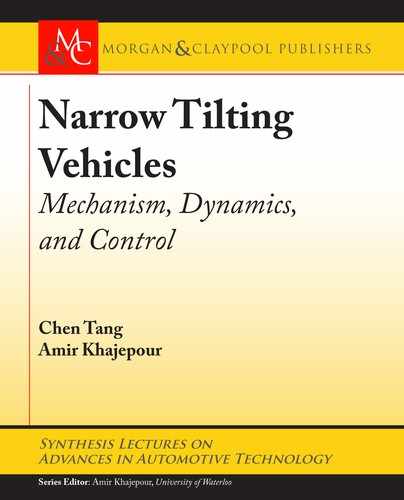
2.2. MECHANISMS FOR FULL TILTING VEHICLES 9
generates chassis tilting as well as wheel cambers, as shown in Figure 2.2b. NTVs equipped such
parallelogram mechanisms in upright mode, tilting mode, and going over a bump during tilting
are illustrated, respectively, in Figure 2.2.
e other widely adopted approach is to enforce wheel vertical movements which then
generates coupled roll motions via suspension kinematics. e schematic is illustrated in Fig-
ure 2.3a, and the implementation using a swing arm mechanism proposed by Edelmann et
al. [22] is shown in Figure 2.3b. More examples of such a mechanism can be seen in [10, 14].
(a) (b)
wheel r
wheel carrier r
wheel carrier 1
wheel 1
swinging arm
rod b r
rod b 1
rod t 1
actuator t 1
actuator b 1
rod t r
actuator t r
actuator b r
suspension subframe
suspension strut
Figure 2.3: Full tilting system based on suspension kinematics: (a) schematic, and (b) imple-
mentation with a swing arm mechanism [22] (image used with permission).
e idea stems from the fact that if wheel assemblies on both sides can move with regard to
the body frame in opposite directions as shown in Figure 2.4b, the vehicle can then actively lean
as a whole piece by regulating the suspension motions. Various suspension mechanisms could be
utilized as long as enough strokes are allowed by the mechanical designs [24]. Demonstrations
of such suspension tilting mechanisms in various modes are illustrated in Figure 2.4.
For the swing arm implementation shown in Figure 2.3b, the suspension sub-frame and
wheel carriers are connected to the chassis by revolute joints. Actuators are attached in between
to generate the desired tilting motion. e swing arm, along with the rods (br; bl; tr; tl), creates
a coupled motion between the wheel carriers on both sides. When one of the wheel carriers goes
up, the swing arm mechanism will cause the other wheel carrier to move downward and thus
generate the tilting motion. However, when both wheel carriers move uniformly, the suspen-
sion sub-frame will rotate relative to the chassis, and the suspension strut can thus absorb road
excitations.

10 2. TILTING MECHANISMS AND ACTUATORS
(a) (b) (c)
Figure 2.4: Suspension tilting systems in different modes: (a) upright mode, (b) tilting mode,
and (c) going over a bump during tilting.
2.3 CHALLENGES IN TILTING MECHANISM DESIGN
After a review of various tilting mechanisms, common challenges in tilting system designs are
summarized below.
Effective Tilting for Vehicle Safety Improvements
As mentioned, compared with full-vehicle tilting schemes, partial-tilting solutions [21, 25, 26]
are less effective for the roll stability control of NTVs. Only a small portion of the whole vehicle
mass is involved in tilting to balance the load, which limits its potential for the emergent and
harsh rollover mitigation. However, if the motivation for adopting the tilting system is riding
comfort enhancement or driving fun improvement, partial-tilting is still a cost-effective solu-
tion due to its relative simple structure and the similarity with conventional vehicles in chassis
designs.
System Packaging and Modularity
Parallelogram tilting mechanisms adopted in [9, 11, 14, 23, 26] provide a directly coupled mo-
tion between chassis and cabin, and thus generate the full vehicle tilting. However, mechanical
linkages for motion synchronization introduce additional complexities to NTVs. Apart from
the extra weights added by the system, the connection rods also occupy the cabin space, and
impose body design restrictions.
e modularity of the suspension system is also sacrificed by such mechanical designs.
Much effort has been devoted to develop urban vehicles in a modularized manner [27–29] to
promote the re-usability of their subsystems. e broad adoption of X-by-wire technologies
(e.g., steer-by-wire, drive-by-wire, brake-by-wire) removes the steering rod and driving shafts
which used to mechanically connect the wheel modules on both sides. Similar technology is
expected to simplify the tilting mechanisms for NTVs.
..................Content has been hidden....................
You can't read the all page of ebook, please click here login for view all page.
